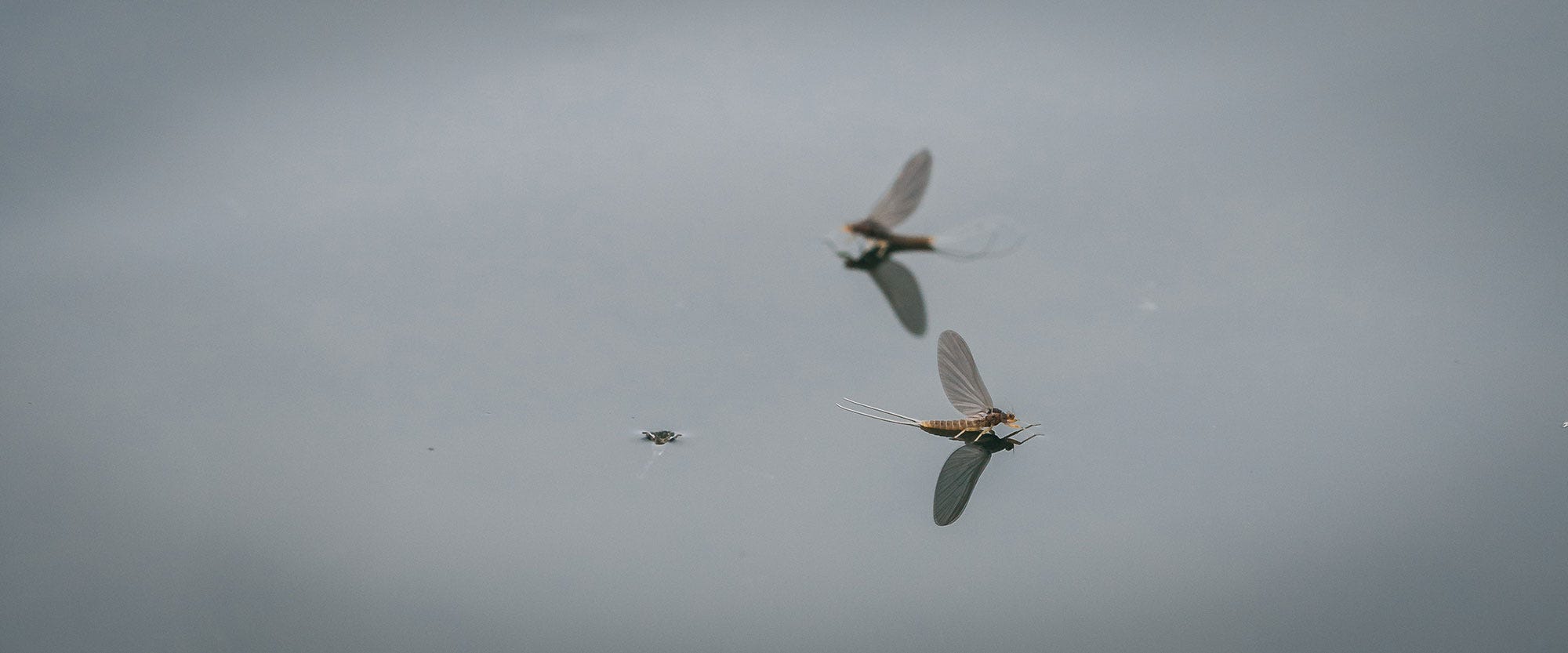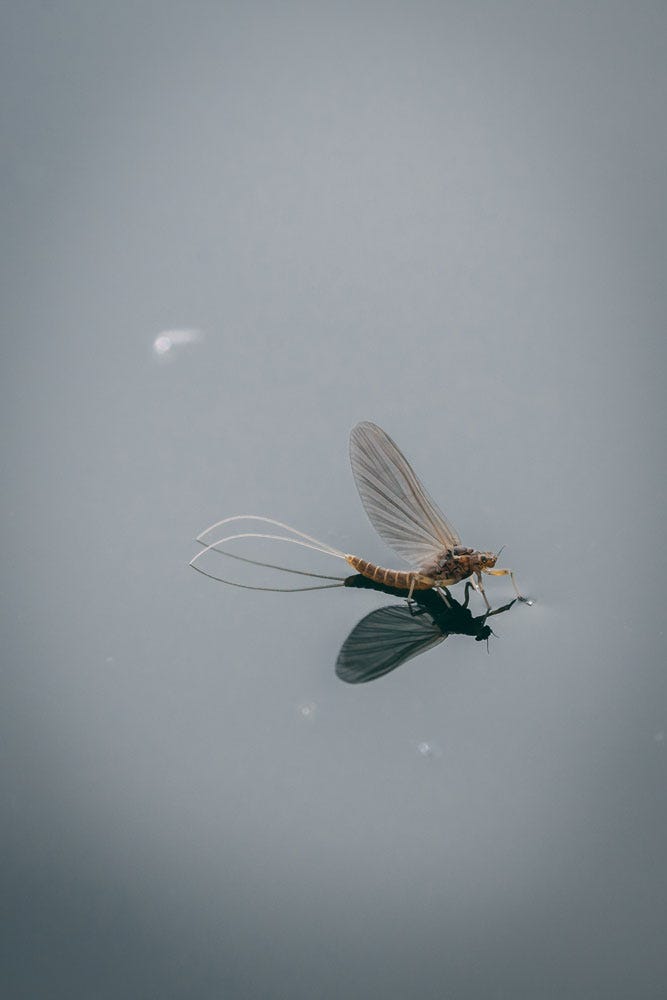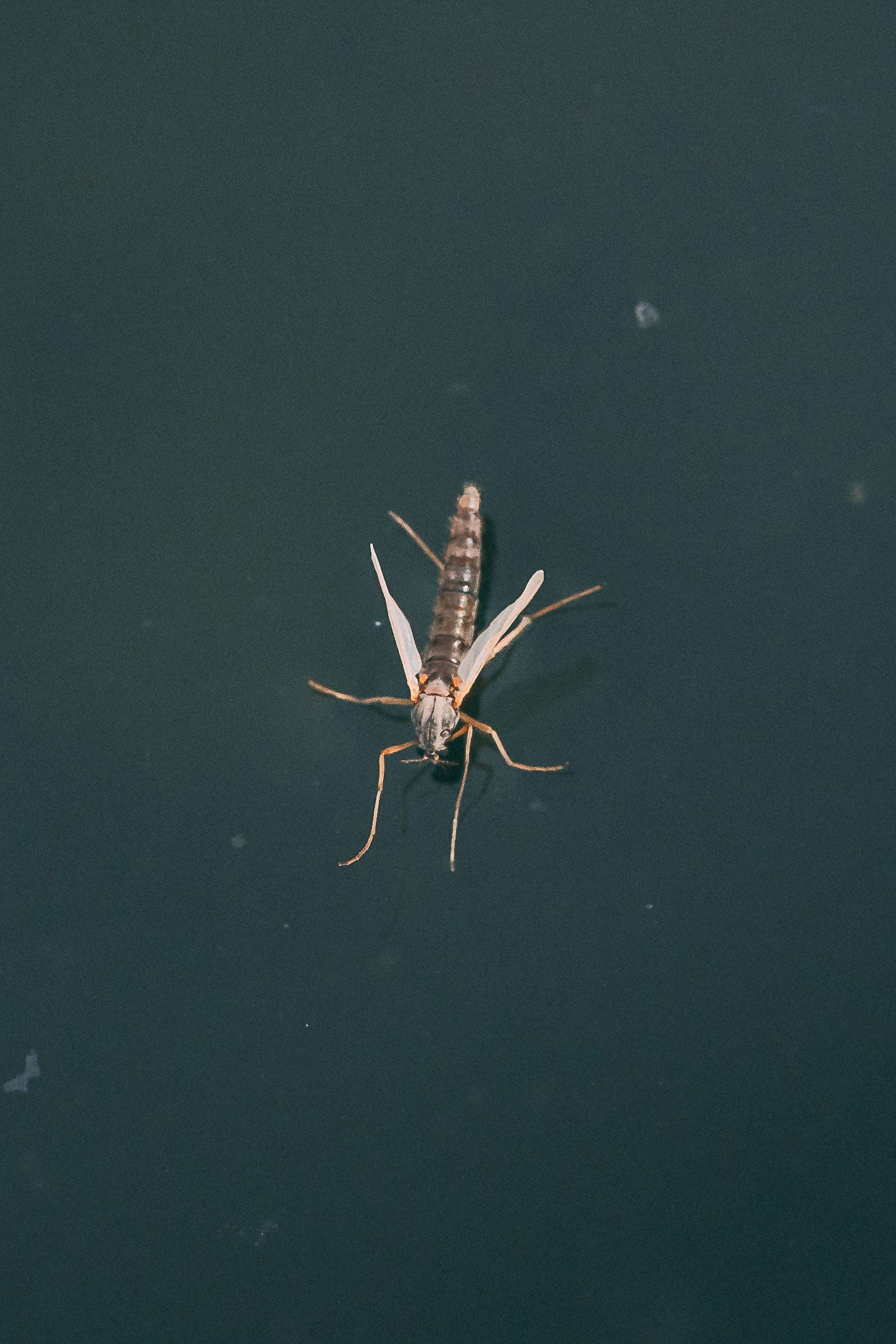Hatch Guide: Spring Blue Winged Olives

One year, on April 1st, I was enjoying a fine spring day. I’d swung some streamers, dredged some nymphs, and decided to see if I could tempt a fish or two on top. Just one fish on a dry would cap off an ideal day. I found a couple of risers sporadically working some midges on the inside channel of a big bar. It took me some time to work around the bar and get into casting position. Just as I was readying my first cast, something magical happened. Little sails began popping up in front of me and three rising fish soon became thirty. For several minutes, I simply watched. Then I attached a #20 bwo parachute to my tippet and started giggling like a little kid as eager fish began slurping my dry fly.
What are BWO's?
There is a large group of mayflies from the family baetidae that we commonly refer to as Baetis, BWOs, or blue-winged olives. Some other names include blue duns and little olives. Whatever you call them, these little mayflies are an important part of a fly fisher’s yearly playbook. I won’t even try to provide a specific scientific name, because the little suckers are constantly being reclassified.
One problem with common names, however, is that they can lead to common misconceptions. Are they all blue-winged? No. In general, they are gray winged, with the potential for a very light bluish or dun cast. Are the bodies all olive? Nope, but they will likely exhibit a shade of olive or a brownish cast on top with a lighter colored belly. Sizing is also variable with bwo hook sizes ranging from #24 up to #16 with #18 and #20 being the most common.
For a laymen such as myself, I prefer to call these small mayflies by their most popular common name—BWOs, even though their size and color vary widely wherever they are found.
TIMING THE HATCH
Hatching can happen as early as February and continue through May. On most waters, the bulk of the hatch occurs when water temps are in the 40’s on up to the lower 50’s. BWOs fade off in warmer summer flows, only to pick up again as temps cool down in the fall. The only time they disappear entirely is during the coldest months of winter. On some temperate spring creeks, BWOs can hatch year-round.




life cycle of the bwo
When it comes to matching the BWO, the key is understanding their life cycle and behavior, so you can fish your imitations the way fish expect to see them. We will focus on the nymphs, emergers, adults and spinners. All of those stages are important to the angler.
Nymphs
Nymphs are always available to fish. They are good swimmers, though they prefer moderate currents. BWO nymphs often exhibit behavioral drift, which means they travel short distances in the current to find new homes. Sunrise and sunset periods feature the strongest movements.
EMERGERS
When emergence kicks in, the nymphs will begin swimming to the surface. The adults use surface tension to break free of their old skin or shuck. Emerger patterns can be deadly when a hatch begins and continue to work into the peak of the emergence.
Hatches often come off like clockwork during prime season windows, though there may be emergences earlier or later than you expect. Hatch times typically vary with the season and water temperatures. Peak season hatches might be expected at 1:30 p.m., but there is a curve to the schedule. Very early spring and late fall hatches may arrive later in the day after water temperatures peak. At the threshold of summer and warmer water temperatures, hatches may arrive progressively earlier in the day until they sputter out.
ADULT BWO's
Hatches take place daily during their seasonal windows, though abundance can vary. Low-pressure weather seems to be a catalyst for stronger hatches. Because of their size, bwos may have some difficulty breaking the surface meniscus, so the hatching process is likely easier during lower pressure. (At least that’s a theory.) True or not, observation has shown that cloudy, dark, and especially drizzly, days generally provide the best bwo surface feeding activity.
During bright higher-pressure days, emergences often seem to be brief or of smaller volume. Maybe it’s the fact that adults are able to fly off the water quicker on a dry sunny day and fish don’t waste the effort to chase them. Of course, as soon as you think you’ve figured out a pattern or a rule, you will likely discover exceptions or variances in different locations or as the seasons change.
When it comes to imitating the adults, cripple patterns are always an excellent choice. Emergence is a difficult process and some adults fail to break free of their shucks or sometimes manage to break free but have deformed or broken wings from the process. Fish quickly learn that the cripples are glued to the water and will not fly away. Using energy to rise to a cripple is always a win. Cripple patterns are also particularly important during a heavy hatch when naturals cover the surface. When fish have plenty of choices, they choose the easiest targets.
BWO spinners
BWO spinner falls are not as notable as those of larger mayflies like the pmd and many anglers don’t pay attention to them. Most dry fly fanatics are always going to be prepared with some spinner patterns though. Spinners can show up on the water almost any time of day but are definitely a key focus later on. If trout have been conditioned to feed on top by some strong daily hatches, they will often keep looking up for any spinners that roll along toward evening.
Of note, most bwos are underwater egg layers. That means the females will crawl down plants or rocks to get under the surface and lay their eggs. Many will be carried along sub-surface after they expire. Dead drifting a sunken wet fly pattern can be effective before and after surface feeding activity is present.


PLAYING THE GAME: BWO HATCHES
BWOs are a big player in the diet of trout on many western rivers. Many anglers choose to focus primarily on the adult phase of the life cycle. While we all love it when the fish are eating dries, hardcore fly fishers want to be prepared to fish every stage of the bwo lifecycle. If you want to crack the code at any given time during daylight hours, you have to cover all stages from nymphs, to emergers, to adults -including the cripples. To complete the cycle, you need to remember to be prepared for spinners and also sunken spent egg layers.
Bwos are a delicate hatch and the flies are small. When it comes to fishing the nymphs, anglers will often add their bwo behind a larger nymph like a scud or a sow bug to start the day. If the majority of fish are coming on the bwo, then running two BWO patterns are a given.
As midday approaches and the nymphs are actively swimming toward the surface, you’ll need to move your flies up in the water column where the action is at. Drifting your nymph and emerger patterns under a micro indicator or dry fly can put your flies up where they need to be.
Once the hatch is happening on the surface, you can focus on almost everyone’s favorite activity. As one of my fishing partners says, “When they are eating dries, it’s like how fly fishing was meant to be.” Setting up to fish bwo dries is about the same as setting up to fish midges. A presentation taper fly line and long tapered leader finished off with 5X is the norm when working the surface. I prefer to take a standard nine-foot 4X nylon tapered leader and add two feet of premium 5X fluorocarbon tippet.
Getting a natural drift can be challenging with tiny flies. Regardless of the rod you choose, it is the line that delivers and fishes the fly. My favorite tools to get the job done are the Scientific Angler amplitude series fly lines. I set my rods up with the textured amplitude trout and the smooth amplitude infinity. Slick lines that cast and feed smoothly will improve your presentations and increase your level of success. Whatever your line choice, make sure it is clean and slick, so you can make the best of prime conditions when a hatch goes off.
On smaller streams, once the hatch is over and there are no more bugs on the water, surface feeding will end abruptly. In larger rivers, however, you may be able to search out some fish feeding on crippled adults washing around in eddies or along the banks, long after the hatch has faded.
Once surface feeding is over, you can go back to drifting nymphs or try tempting fish on sunken wets that imitate the drowned adults or expired egg layers. The fish will always be feeding on something. It’s up to you to figure out what it is. That, to me, is one of the things that makes fly fishing so interesting. That’s the challenge and the fun of matching the BWO.



